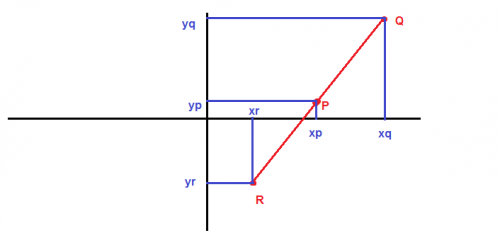-
Posts
926 -
Joined
-
Last visited
Content Type
Profiles
Forums
Events
Posts posted by Function
-
-
Did you find this in Trachtenberg?
(Note that I edited the formula - it contained a small mistake)
...Trachten-what?
I don't know who/what that is, so I'd say no.. I just wanted to make a general formula for squaring terms of the series 1, 11, 111, 1111, 11111, ... in function of n, with n = (the amount of ones in the value - 1).
...So I did.
However I think this formula I found, i.e. [math]\left[\sum_{i=0}^{n}{10^i}\right]^2=\sum_{i=0}^{n}{\left[10^{2n-i}\left(i+1\right)+i\cdot 10^{i-1}\right]}[/math] was probably already known (or perhaps another formula if this one's incorrect), I'd like to know if it's correct

Matter of testing my mathematical capacities (read: insight)
 0
0 -
Well, there can be a simple formula that can be used(depending what you mean by general).
[math]n^{2}[/math]
Where n is the amount of ones in the value. Do you want an equation where you can enter the actual value containing the ones so it puts it in the square form?
Lol.. Well, my main question now is if my last given formula is right.. (I edited my post a 'bit')?
0 -
I don't know how to ask this question, so I'll just give something; my question: is there a formula which can put this 'phenomenon' in a general form?
[math]1^2 = 1[/math]
[math]11^2 = 121 \rightarrow 1+2+1=4=2^2[/math]
[math]111^2=12321\rightarrow 1+2+3+2+1=9=3^2[/math]
[math]1,111^2=1234321\rightarrow 1+2+3+4+3+2+1=16=4^2[/math]
[math]\cdots[/math]
How can this be put in a general, mathematically more plausible expression?
I think that this is a 'crucial' part of it: (I found it about a few minutes ago; sorry if it's wrong, haven't seen summations in school yet..) (To be honest, I'm pretty happy with the result that I found this ^^ )
[math]\left[\sum_{i=0}^{n}{10^i}\right]^2=\sum_{i=0}^{n}{\left[i\cdot 10^{i-1}\right]}+\sum_{i=0}^{n}{\left[\left(i+1\right)\cdot 10^{2n-i}\right]}[/math]
And I think the sum of the numbers of the square of this is:
[math]2\left[\sum_{i=0}^{n}{i}\right]+(n+1)[/math]
So, my conclusion would be:
[math]\forall n\in\mathbb{N}: 2\left[\sum_{i=0}^{n}{i}\right]+(n+1)=n^2[/math]
So, actually, the whole first step wasn't necessary after all.. But, I personally think it's a nice formule to display the series 1, 11, 111, 1111, 11111, ...

I'm pretty sure the last thing is correct; my main question (sorry that I have changed it) is now: is this formula correct?
[math]\left[\sum_{i=0}^{n}{10^i}\right]^2=\sum_{i=0}^{n}{\left[i\cdot 10^{i-1}\right]}+\sum_{i=0}^{n}{\left[\left(i+1\right)\cdot 10^{2n-i}\right]}[/math]
[math]\left[\sum_{i=0}^{n}{10^i}\right]^2=\sum_{i=0}^{n}{\left[10^{2n-i}\left(i+1\right)+i\cdot 10^{i-1}\right]}[/math]
0 -
The calculation of errors adn uncertainty is a lot more complicated than just counting significant figures.
http://www.bipm.org/utils/common/documents/jcgm/JCGM_100_2008_E.pdf
Well, yes, I know...
But this topic was mainly about significant figures...
About uncertainty; I found out that the 'uncertain' result of a measurement is equal to the answer with no uncertainties plus or minus the most extreme uncertainties:
e.g. the measurement of the surface of an A4-sheet of paper without using significant figures:
I measure a width of [math]21\pm 0.1 cm[/math] and a length of [math]29.6\pm 0.1cm[/math]
The surface is (if I'm correct) i.c.: [math](621.6\pm 5.07)cm^2\left(=21\cdot 29.6\pm (2.1+2.96+0.01)\right)[/math]
0 -
Hello everyone
I have a question about something I really can't stand in physics: approximates
(the rules which say that if you have a sum or a difference, the result may not be more accurate than the less accurate term; if you have a product or a quotient (ratio?), the number of significant figures may not be higher than the number of significant figures of the factor with the less significant figures)
(I can't stand these approximates for their inaccuracy
 )
)To exercise this, I've used a self-made example:
A bullet is being shot at a height of [math]276.457 m[/math], under an angle [math]\theta[/math] of [math]0.524 rad[/math] and with an initial velocity of [math]87.78\frac{m}{s}[/math].
How much has the bullet dropped after it has flown [math]74.5m[/math] in a one-dimensional way?
Using 'the formula' of the trajectory of a projectile:
[math]y=y_0+x\cdot \tan{\theta}-\frac{gx^2}{2v^2\cos^2{\theta}}[/math]
[math]y = 276.457m + 74.5m\cdot 0.578 - \frac{9,81\frac{m}{s^2}\cdot 74.5\cdot 74.5}{2\cdot 87.78\cdot 87.78 \cdot 0.866\cdot 0.866}[/math]
Lowest accuracy is 3 significant figures in numerator and 1 significant figure in denominator
[math]=276.457 + 43.1 - \frac{5.44\cdot 10^4}{1\cdot 10^4}[/math]
Lowest accuracy is 1 significant figure
[math]= 276.457 + 43.1 - 5[/math]
Lowest accuracy is one unit
[math]= 3\cdot 10^2 m[/math]
Is this correct?
Thanks.
-Function
0 -
You may want to restrict the second one to the right-handed limit, i.e.
[math]e=\lim_{n\to 0^+}{\left[n+1\right]^{\frac{1}{n}}}[/math]
Then, we can easily see that the two are equivalent by looking at the first limit and letting [math]n = \frac{1}{n'}[/math].
Thanks
 0
0 -
Hello everyone
I've seen 2 definitions for [math]e[/math] (one on the internet, one I have proven myself):
[math]e=\lim_{n\to\infty}{\left[1+\frac{1}{n}\right]^n}[/math]
and
[math]e=\lim_{n\to 0}{\left[n+1\right]^{\frac{1}{n}}}[/math]
Now, is there a proof that these two are equal? (I'd first like to know if I can change the first expression to something in the form of [math]n\to 0[/math].)
Thanks!
Function
0 -
Not anymore, I edited it.. Sorry for waisting your time!
0 -
Hello everyone
My book gives us a proof for the rule of de l'Hôpital and to do this, its first statement is:
[math]\frac{f(x)}{g(x)}=\frac{f(x)-f(a)}{g(x)-g(a)}[/math]
However, I don't agree with this... Or I have no idea where that comes from... e.g.:
[math]f(x)=6x^3+2x^2+4[/math] and [math]g(x)=8x^2+3x+1[/math]
[math]\frac{f(3)}{g(3)}=2,243...\neq\frac{f(3)-f(7)}{g(3)-g(7)}=5,951...[/math]
What's wrong with this?
Thanks.
Function
Nope, wait.. I oversaw that [math]f(a)=g(a)=0[/math]
Sorry (...again..)
0 -
Hello everyone
I love to see Derren Brown (mentalist, illusionist) at work; he manipulates one's brain into believing or thinking what he wants one to believe or think; a very simplistic example I used on a friend of mine (without him knowing of it):
I asked this friend to pick a random number from 0 to 10. I would guess that number.
I guessed correctly: 8.
Well, ok.. There's a chance of 1/10, which is relatively big.
How I made him pick 8? Just say a lot of phrases in which the word/pronunciation 'eight' (~ 'ait') is hidden subtle.
So, this is a very simple form of what I think is called (hypnotic) suggestion, and I was wondering if anyone knows if this is hypnotic suggestion, and if someone could give me more fun experiments I could practice

Thanks!
Function
0 -
Now that is what I wanted
 Thanks.0
Thanks.0 -
Why can you not simply take the average, rather than mess about with moduli?
Because I wanted to prove it another way. What you give me is exactly that what I didn't want to see, for we had already proven it in class
 0
0 -
Ok, new reasoning: you may assume that it is true that P is the middle of [QR], and the given coördinates for P, Q and R are right.
Here's my new reasoning; I only want to know if it's plausible as proof
-------
For the expression:
[math]|x_q-x_p|=|x_p-x_r|[/math]
[math]\Leftrightarrow \left| \frac{a\cdot \cos{t}}{1-\sin{t}} - \frac{a}{\cos{t}} \right| = \left| \frac{a}{\cos{t}} - \frac{a\cdot\cos{t}}{1+\sin{t}} \right|[/math]
There are 2 solutions:
1) [math]\frac{a\cos{t}}{1-sin{t}} - \frac{a}{\cos{t}}=\frac{a}{\cos{t}}-\frac{a\cos{t}}{1+\sin{t}}[/math]
[math]\Leftrightarrow \frac{\cos^2{t}}{(1-\sin{t})\cos{t}} - \frac{1-\sin{t}}{\cos{t}(1-\sin{t}} = \frac{1+\sin{t}-cos^2{t}}{\cos{t}(1+\sin{t})}[/math]
[math]\Leftrightarrow \frac{1-\sin{t}+\cos^2{t}}{\cos{t}(1-\sin{t})} = \frac{1+\sin{t}-\cos^2{t}}{\cos{t}(1+\sin{t})}[/math]
[math]\Leftrightarrow 1-\sin{t}+\cos^2{t}+\sin{t}-\sin^2{t}+\sin{t}\cos^2{t}=1+\sin{t}-\cos^2{t}-\sin{t}-\sin^2{t}+\sin{t}\cos^2{t}[/math]
[math]\Leftrightarrow \cos^2{t}=-\cos^2{t}[/math]
[math]\Leftrightarrow \cos{t}=0[/math]
[math]\Leftrightarrow t=\frac{\pi}{2}+k\cdot\pi[/math]
2) [math]\frac{a\cdot \cos{t}}{1-\sin{t}} - \frac{a}{\cos{t}} = \frac{-a}{\cos{t}} + \frac{a\cdot\cos{t}}{1+\sin{t}}[/math]
[math]\Leftrightarrow 1-\sin{t}=1+\sin{t}[/math]
[math]\Leftrightarrow \sin{t}=0[/math]
[math]\Leftrightarrow t=k\cdot\pi[/math]
For the expression:
[math]|y_r+y_p|=|y_q-y_p|[/math]
[math]\Leftrightarrow \left| \frac{-b\cos{t}}{1+\sin{t}} + b\tan{t} \right| = \left| \frac{b\cos{t}}{1-\sin{t}}-b\tan{t} \right|[/math]
There should've been 2 solutions, were it not that [math]\frac{\pi}{2}+k\cdot\pi[/math] is also a solution for [math]t[/math].
[math]\Rightarrow \frac{\pi}{2}+k\cdot\pi[/math] is not a solution for [math]t[/math].
[math]\Rightarrow[/math] if the expression [math]|y_r+y_p|=|y_q-y_p|[/math] has [math]k\cdot\pi[/math] as a solution for [math]t[/math], what had to be proven, is proven.
[math]\Leftrightarrow \left| \frac{-b\cos{t}}{1+\sin{t}} + b\tan{t} \right| = \left| \frac{b\cos{t}}{1-\sin{t}}-b\tan{t} \right|[/math]
[math]\frac{-b\cos{t}}{1+\sin{t}} + b\tan{t}=\frac{-b\cos{t}}{1-\sin{t}}+b\tan{t}[/math] is a solution for the equality.
[math]\Leftrightarrow 1+\sin{t}=1-\sin{t}[/math]
[math]\Leftrightarrow \sin{t}=0[/math]
[math]\Leftrightarrow t=k\cdot\pi[/math]
Both the expressions [math]|y_r+y_p|=|y_q-y_p|[/math] and [math]|x_q-x_p|=|x_p-x_r|[/math] both have [math]k\cdot\pi[/math] as a solution for [math]t[/math]. The expressions are true.
I'm actually afraid that isn't a proof that the expressions are true... They only express that [math]t[/math] must be [math]k\cdot\pi[/math], which isn't the case. I'm sure my reasoning is true; where's my miscalculation?
0 -
Auto-answered: my science (chemistry and physics) teacher (is this a correct term in English? I speak Dutch..) has some test sets to get the information I required.
0 -
Now I'm embarrassed.
0 -
Thanks, Sensei. Your proof is very clear

Another problem: elastic potential energy:
[math]E_{pe}=\frac{k\cdot\Delta l}{2}[/math]
[math]J=\frac{\frac{N}{m}\cdot m}{2}=\frac{N}{2}[/math]
[math]E_{pe}=\frac{F}{2}[/math]
[math]E_{pe}=\frac{m\cdot a}{2}[/math]
[math]J=\frac{1}{2}\cdot kg\cdot \frac{m}{s^2}[/math]
[math]J=\frac{kg\cdot m}{2s^2}\neq \frac{kg\cdot m^2}{2s^2}[/math]
Where did the extra m go?
0 -
Ah yes, well.. I forgot to put in the value of g..
My bad!
0 -
Hello everybody
I have a question concerning the formulas of energy and its unit
[math]E=\frac{m\cdot v^2}{2}[/math]
[math]1 J=\frac{1 kg\cdot 1 m^2}{2\cdot 1 s^2}[/math]
and
[math]E=m\cdot g\cdot h[/math]
[math]1 J=1 kg\cdot\frac{1 m}{1 s^2}\cdot 1 m=\frac{1 kg\cdot 1 m^2}{1 s^2}[/math]
And because [math]E_k=E_p[/math] (e.g. a mass falling from a height its potential energy will be converted to kinetic energy when on its lowest point):
[math]J=\frac{kg\cdot m^2}{s^2}=\frac{kg\cdot m^2}{2\cdot s^2}[/math]
[math]\Leftrightarrow \frac{1}{2}=1[/math]
What is wrong with my reasoning?
Thanks!
Function
0 -
Given:
Vacid = 0,01 L
VKOH = 0,02742 L
cKOH = 0,168 M = 0,168 moles/L
Asked: Macid = [math]\frac{m_{acid}}{n_{acid}}[/math]
Conclusion: too few information given
 0
0 -
maths
in Mathematics
If there's no S, do you mean "Wikunde" ?
Touché...
Well, you know what I mean

very simple in Dutch: no s at the end: Physics = fysica/natuurkunde; math(s) = wiskunde (or if you go a bit 'far'; mathematiek
0 -
Well, I just want to know if the last equation in my first post can be proven, in the form of, for example, |a| = |-a|, which is correct, and thus it is proven.
A quick sketch of the tangent with tangent point P and intersections with asymptotes Q and R:
To be proven: P is the middle of [QR] with Q and R given (in my first message).
I wanted to prove this, other than by using the formula to get the distance |PQ| and |PR| or using the formula of calculating the mdidle of a segment ((x1+x2)/2;(y1+y2)/2).
Therefore, I reasoned this:
In order for P to be the middle of [QR], 2 requirements must be met:
|xp-xr| = |xq-xp| and |yr+yp| = |yq-yp|. (I use the point symmetrical property: Q and R are point symmetrical over P)
When I fill in the coördinates of R, Q and P, you get the last equation of my first message.
Can that equation be proven, so I get something in the form of |a| = |-a| at the end, and thus I get something which proves that P is the middle of [QR]?
Thanks.
(Sorry for my lack of mathematical English, btw... I live in Belgium, and we don't really handle mathematical/scientifical English)
0 -
(Of course, I don't simply want to quadrate both sides)
0 -
Hello everyone
In math class, we've proven something that had to do something with tha tangent of a hyperbola:
the tangent point P is the middle point of [QR] with Q the intersection of the tangent and one assymptote, and R the intersaction of the tangent with the other assymptote.
After we've calculated the values for:
[math]Q\left( \frac{a\cdot\cos{t}}{1-\sin{t}};\frac{b\cdot\cos{t}}{1-\sin{t}} \right)[/math]
[math]R\left( \frac{a\cdot\cos{t}}{1+\sin{t}};\frac{-b\cdot\cos{t}}{1+\sin{t}} \right)[/math]
[math]P\left( \frac{a}{\cos{t}};b\cdot\tan{t} \right)[/math]
we started expressing that P is middle of [QR], and getting an equality.
However: I claimed this could've gone a bit more easy (my math teacher asked me therefore to present her a proof):
P is the middle of [QR]
[math]\Leftrightarrow Q [/math] and [math]R[/math] are point symmetrical over P.
[math]\Leftrightarrow |x_q-x_p|=|x_p-x_r|[/math]
[math]\Leftrightarrow \left|\frac{a\cdot\cos{t}}{1-\sin{t}}-\frac{a}{\cos{t}}\right|=\left|\frac{a}{\cos{t}}-\frac{a\cdot\cos{t}}{1+\sin{t}}\right|[/math].
But what now? I can't just scrap the "absolute value"-signs..
Is there a way to proof that equation?
Thanks!
-Function
0 -
maths
in Mathematics
let's all just speak Dutch

can't be easier: Math(s?) = Wiskunde..
that's it. No s, no discussions on how to write it
 0
0




1, 11, 111, 1111, ... squared
in Mathematics
Posted · Edited by Function
Now that's unsettling.
Nevertheless; is 'my' formula in #5 correct?
Following that formula, and keeping in mind that my calculator (TI-84 Plus) may have rounding inaccuracies, it gives for both left part and right part of the formula in message #5:
1.234567901E20